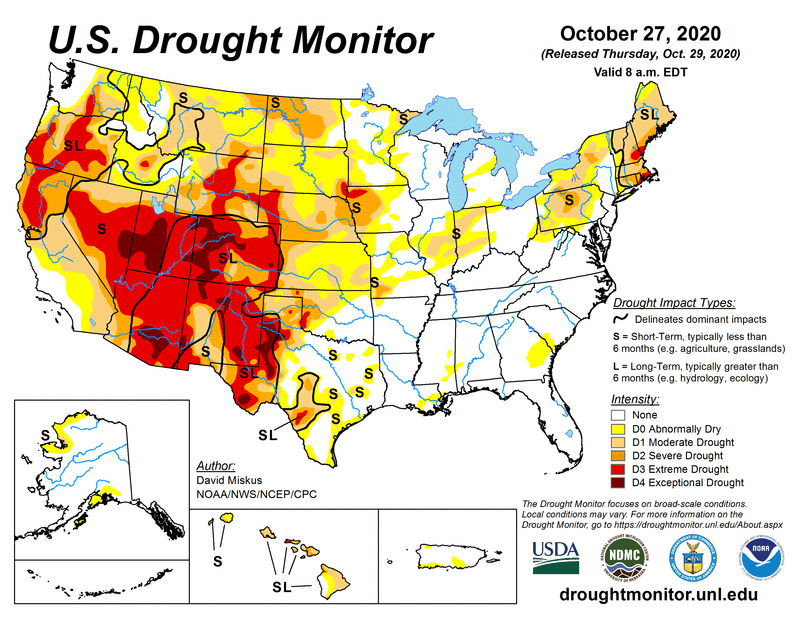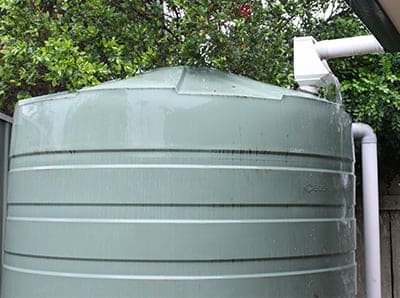 At the time of this writing, the American Intermountain/Southwest is in the grip of an extensive drought. 100% of the population of the Four-Corners states (Utah, Colorado, New Mexico, and Arizona) and Nevada are experiencing D1 or worse drought, which makes what little water there is that much more precious. And while use of the water in rivers, reservoirs, and aquifers is subject to highly negotiated rights, and the use of wells is dependent on the location of the wells, there is a source of water that is gaining in popularity, despite its irregularity: rainwater.
At the time of this writing, the American Intermountain/Southwest is in the grip of an extensive drought. 100% of the population of the Four-Corners states (Utah, Colorado, New Mexico, and Arizona) and Nevada are experiencing D1 or worse drought, which makes what little water there is that much more precious. And while use of the water in rivers, reservoirs, and aquifers is subject to highly negotiated rights, and the use of wells is dependent on the location of the wells, there is a source of water that is gaining in popularity, despite its irregularity: rainwater.
Catching, harvesting, or collecting rainwater is legal in all 50 states. Several states have adopted restrictions on how much rainwater can be collected (Colorado and Utah), where or what kind of water can be collected (Colorado, Idaho, Oregon, Texas), or how it can be used (Arkansas, California, Colorado [anyone else see a theme here?], Georgia, Kansas, Nevada, Ohio), as shown in this graphic. Colorado (pdf) and Utah (pdf) currently have the most stringent restrictions on rainwater collection and storage (maximum of 110 gallons total capacity; and maximum of two barrels up to 100 gallons each for unregistered catchment, maximum 2,500 gallons registered, respectively). The most common usage restrictions limit collected rainwater to non-potable or outdoor uses.
 How, then, does one go about collecting rainwater? The most basic setup, it would seem, would be a bucket set under the eaves or downspout of one's dwelling. It certainly would be catching or harvesting rainwater. But storing? Not so much. So, rather than a bucket, upgrade to a barrel with a lid. Excellent! But what size barrel to get? A quick check with a precipitation history map will help determine what size barrel (or even cistern!) make the most sense for the yearly precipitation in one's area. But then how to get the water out? Gravity-fed spigot; pour spout on top (smaller barrels only); pump handle; fractional horsepower electric pump? All of these are feasible and available solutions. Again, determining which solution fits any specific situation depends the amount of precipitation and how much of that precipitation is intended to be stored and dispensed.
How, then, does one go about collecting rainwater? The most basic setup, it would seem, would be a bucket set under the eaves or downspout of one's dwelling. It certainly would be catching or harvesting rainwater. But storing? Not so much. So, rather than a bucket, upgrade to a barrel with a lid. Excellent! But what size barrel to get? A quick check with a precipitation history map will help determine what size barrel (or even cistern!) make the most sense for the yearly precipitation in one's area. But then how to get the water out? Gravity-fed spigot; pour spout on top (smaller barrels only); pump handle; fractional horsepower electric pump? All of these are feasible and available solutions. Again, determining which solution fits any specific situation depends the amount of precipitation and how much of that precipitation is intended to be stored and dispensed.
The final question to be answered before purchasing a collection system is a variation of the one that will have to be answered continuously after installation: how will I know how much water is in the barrel? Some collection containers will come with float level indicators installed. But those only work when you are looking at them. If you want any kind of remote indication (i.e., a low- or high-level indicator light inside the dwelling where the collection system is installed), an electronic level indicator will be necessary. Simple float switches can provide 'Yes' or 'No' indications at specific levels, while more complicated float switches or combinations can indicate multiple levels. For the rare situations where a continuous level indication is needed on a rainwater collection system, an ultrasonic level sensor, submersible pressure transducer, or a pressure transducer mounted near the bottom of the tank on the outside can provide the necessary measurement.
One of our favorite sayings here at APG applies to rainwater harvesting as much as it does to the rest of our level and pressure business: the application determines everything. There are no one-size-fits-all answers. Where one is looking to set up for rainwater harvesting will determine what, if any, permits or licenses are necessary, the ways that the collected water can be used, and how much water will be available to collect. Once the basics are settled, the fun begins: how many barrels are needed? What size barrels? What kind of feeding system from downspouts to the collection barrels makes the most sense? What kind of level indicators should be used? See? The fun questions!
If you have more questions about rainwater harvesting, check out the American Rainwater Catchment Systems Association. Their mission is "[t]o provide resources and information on rainwater and stormwater collection to promote the advancement of rainwater conservation and to work with government at all levels in promoting rainwater and stormwater management." In Canada, the Canadian Association for Rainwater Management performs much the same function.
If you have questions about level measurement, in rainwater or any other liquid or even some solids, our Measurement Experts can give you expert guidance, based on your particular application. We promise no 'pat answers.' You can call them, send them an email, or even live chat with them here on this page.
top photo credit: The U.S. Drought Monitor is jointly produced by the National Drought Mitigation Center at the University of Nebraska-Lincoln, the United States Department of Agriculture, and the National Oceanic and Atmospheric Administration. Map courtesy of NDMC. and NIDIS Drought.gov.
bottom photo credit: Jan Smith via flickr.com Creative Commons 2.0